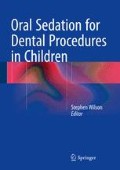Abstract
The execution of a well-conceived protocol or plan aids in the efficacy, efficiency, and safety of a sedation appointment. The protocol acts like a guide for the clinician to follow in performing a sequence of events aimed at increasing successful outcomes of oral sedations of children in the dental setting. Little has been written on this topic in pediatric dentistry, although protocols for dental procedures are readily learned by dental professionals early in their career. This chapter presents a generalized model in which several considerations and elements associated with a “typical” sedation protocol and process are addressed. Various aspects of patient selection, intraoperative patient guidance, monitoring, and other related procedures are reviewed.
Access this chapter
Tax calculation will be finalised at checkout
Purchases are for personal use only
References
American Academy of Pediatrics, American Academy of Pediatric Dentistry, Cote CJ, Wilson S, Work Group on Sedation. Guidelines for monitoring and management of pediatric patients during and after sedation for diagnostic and therapeutic procedures: an update. Pediatrics. 2006;118(6):2587–602.
Cordero N, Cárdenas JM, Alvarez LG. Parental acceptance of pharmacologic and non-pharmacologic behavior management techniques in pediatric dentistry. Revista CES Odontología. 2012;25(2):24–32.
Eaton JJ, McTigue DJ, Fields Jr HW, Beck M. Attitudes of contemporary parents toward behavior management techniques used in pediatric dentistry. Pediatr Dent. 2005;27(2):107–13.
Elango I, Baweja DK, Shivaprakash PK. Parental acceptance of pediatric behavior management techniques: a comparative study. J Indian Soc Pedod Prev Dent. 2012;30(3):195–200.
Havelka C, McTigue D, Wilson S, Odom J. The influence of social status and prior explanation on parental attitudes toward behavior management techniques. Pediatr Dent. 1992;14(6):376–81.
Lawrence SM, McTigue DJ, Wilson S, Odom JG, Waggoner WF, Fields Jr HW. Parental attitudes toward behavior management techniques used in pediatric dentistry. Pediatr Dent. 1991;13(3):151–5.
Muhammad S, Shyama M, Al-Mutawa SA. Parental attitude toward behavioral management techniques in dental practice with schoolchildren in Kuwait. Med Princ Pract. 2011;20(4):350–5.
Murphy MG, Fields Jr HW, Machen JB. Parental acceptance of pediatric dentistry behavior management techniques. Pediatr Dent. 1984;6(4):193–8.
Luis de Leon J, Guinot Jimeno F, Bellet Dalmau LJ. Acceptance by Spanish parents of behaviour-management techniques used in paediatric dentistry. Eur Arch Paediatr Dent. 2010;11(4):175–8.
Abushal MS, Adenubi JO. Attitudes of Saudi parents toward behavior management techniques in pediatric dentistry. J Dent Child (Chic). 2003;70(2):104–10.
Brandes DA, Wilson S, Preisch JW, Casamassimo PS. A comparison of opinions from parents of disabled and non-disabled children on behavior management techniques used in dentistry. Spec Care Dentist. 1995;15(3):119–23.
Wilson S, Antalis D, McTigue DJ. Group effect on parental rating of acceptability of behavioral management techniques used in pediatric dentistry. Pediatr Dent. 1991;13(4):200–3.
Fishbaugh DF, Wilson S, Preisch JW, Weaver 2nd JM. Relationship of tonsil size on an airway blockage maneuver in children during sedation. Pediatr Dent. 1997;19(4):277–81.
Arnrup K, Broberg AG, Berggren U, Bodin L. Treatment outcome in subgroups of uncooperative child dental patients: an exploratory study. Int J Paediatr Dent. 2003;13(5):304–19.
Isik B, Baygin O, Kapci EG, Bodur H. The effects of temperament and behaviour problems on sedation failure in anxious children after midazolam premedication. Eur J Anaesthesiol. 2010;27(4):336–40.
Jensen B, Stjernqvist K. Temperament and acceptance of dental treatment under sedation in preschool children. Acta Odontol Scand. 2002;60(4):231–6.
Lochary ME, Wilson S, Griffen AL, Coury DL. Temperament as a predictor of behavior for conscious sedation in dentistry. Pediatr Dent. 1993;15(5):348–52.
Lee JY, Vann WF, Roberts MW. A cost analysis of treating pediatric dental patients using general anesthesia versus conscious sedation. Pediatr Dent. 2000;22(1):27–32.
Litman RS, Kottra JA, Berkowitz RJ, Ward DS. Upper airway obstruction during midazolam/nitrous oxide sedation in children with enlarged tonsils. Pediatr Dent. 1998;20(5):318–20.
Goho C. Oral midazolam-grapefruit juice drug interaction. Pediatr Dent. 2001;23(4):365–6.
Isik B, Baygin O, Bodur H. Effect of drinks that are added as flavoring in oral midazolam premedication on sedation success. Paediatr Anaesth. 2008;18(6):494–500.
Houpt MI, Limb R, Livingston RL. Clinical effects of nitrous oxide conscious sedation in children. Pediatr Dent. 2004;26(1):29–36.
Author information
Authors and Affiliations
Corresponding author
Editor information
Editors and Affiliations
Rights and permissions
Copyright information
© 2015 Springer-Verlag Berlin Heidelberg
About this chapter
Cite this chapter
Wilson, S. (2015). Protocol. In: Wilson, S. (eds) Oral Sedation for Dental Procedures in Children. Springer, Berlin, Heidelberg. https://doi.org/10.1007/978-3-662-46626-1_8
Download citation
DOI: https://doi.org/10.1007/978-3-662-46626-1_8
Publisher Name: Springer, Berlin, Heidelberg
Print ISBN: 978-3-662-46625-4
Online ISBN: 978-3-662-46626-1
eBook Packages: MedicineMedicine (R0)

